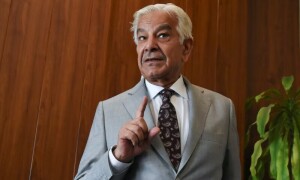Pakistan’s foreign exchange reserves held by its central bank plunged to $7.74 billion on Sept 27 from $8.46bn a week ago. But foreign exchange markets remained calm and the rupee remained stable during the week.
This huge fall in the reserves was presumably a result of the quarter-end external debt servicing. But is it also a sign of the pressure the exchange rate might feel in the future? It could be so if we keep in mind that the rupee did not come under pressure in July-September despite heavy debt servicing partly because the State Bank of Pakistan (SBP) continued supporting it. The reserves had to fall towards the end of the quarter as the central bank squared off its foreign exchange positions to avoid emerging as a net seller of dollars to banks.
Under the current IMF lending programme, the SBP is not barred from selling dollars in the foreign exchange market to check volatility. But it is supposed to square off all such sales by the end of the quarter.
Since the beginning of this fiscal year, the rupee has remained stable: it rather gained 2.3 per cent value against the dollar during the first quarter ending on Sept 30. But is this trend sustainable?
SBP reserves can’t cover even two months of our significantly reduced merchandise imports
In the last fiscal year, Pakistan borrowed billions of dollars from multiple sources, including Saudi Arabia, China and the United Arab Emirates. That help was crucial in managing external debt servicing.
At the start of this fiscal year, the country received $991.4m as the first tranche of the IMF’s loan of $6bn. This has helped the SBP maintain a minimum level of foreign exchange reserves.
Since July, we have also been receiving up to $275m worth of oil supplies from Saudi Arabia on deferred payment and that has eased the pressure of demand for dollars. Small wonder then the rupee rose to 156.36 to a dollar on Sept 30, up 2.3pc from 160.05 on June 30 and kept trading around the same level until Oct 3. Foreign exchange reserves of the SBP also increased to $7.74bn on Sept 27 from $7.28bn at the end of June.
Despite this improvement, the central bank’s reserves are short of covering even two months of our significantly reduced merchandise imports. This should be a cause for serious concern for both the Ministry of Finance and the SBP.
Read: Trade deficit falls sharply by 38pc in July-August
Pakistan’s trade deficit reduced significantly from $6.12bn in July-August 2018 to $3.92bn in July-August 2019. But less demand for oil in a sluggish economy, lower oil prices and an increase in import duties on non-essential goods have all played a hand in it. Now that international oil prices are on the rise after a terrorist attack on Saudi oil installations, imports of oil might see some increase because we don’t import all of our oil from Saudi Arabia.
After the attack on Saudi oil facilities, oil prices have spiked. So our import bill is going to rise in coming months. Monthly imports of oil on deferred payment are allowed up to a certain amount. Beyond that, oil import bills have to be cleared on due dates. The trade deficit has declined owing to a cut in the import bill and not because of huge gains in exports.
Exports are growing too slowly (up only 2.8pc in July-August). And with the global economy slowing down and our export-limiting domestic structural issues remaining in place, one cannot expect a quick and large increase in export earnings. Remittances have also started declining. In July-August, they were down 8.4pc year on-year.
The Gulf region, from where we get more than half of our remittances, is braving its own economic issues amidst growing security challenges. Saudi Arabia and the United Arab Emirates continue to localise jobs and the former has begun expelling hundreds of thousands of immigrants on charges of illegal stay. Amidst this situation, the scope for growth in total remittances remains low.
The government has so far failed to accelerate foreign direct investment (FDI) though portfolio investment continues to get some inflows. In July-August, FDI inflows plunged to $156m from $377m a year ago. This is in line with the trend in the recent past as FDI slumped to $1.66bn in 2018-19 from $2.75bn in 2017-18. This is as much a reflection of inconsistent and less realistic policies of the PTI as it is of the regional security environment and shift in global investors’ priorities.
One reason why we are not getting enough foreign investment is that local investment remains sluggish, which sends a negative signal to foreign investors. Now Prime Minister Imarn Khan and Chief of Army Staff Gen Qamar Javed Bajwa are trying to convince local business tycoons to be confident about the economy and accelerate their investment activities. In a recent meeting with top businessmen, Prime Minister Khan told business leaders that the National Accountability Bureau would no more be investigating cases of tax-evasion, a practice that had scared businessmen to the extent that many of them deliberately slowed their business activities.
Published in Dawn, The Business and Finance Weekly, October 7th, 2019















































